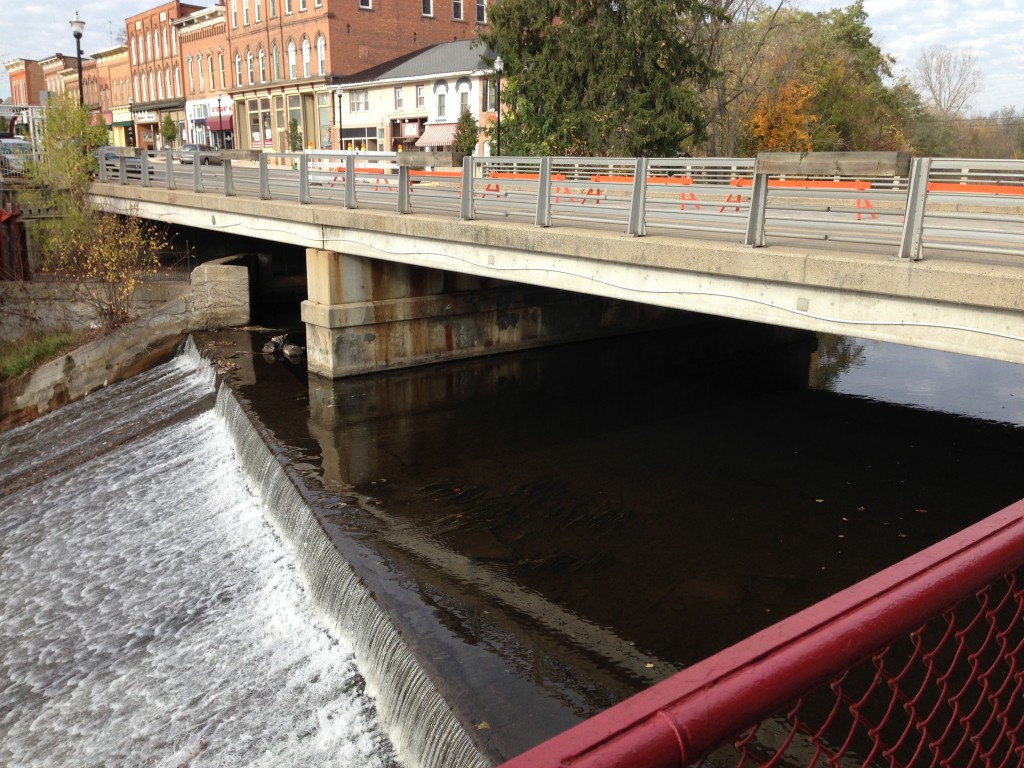The Five Lives of the Main Street Bridge, Part Five of Five
Bridge #5 – The 1972 Concrete and Steel Bridge Replacement
The long-term effects of a larger number of vehicles, heavier loads, heavier trucks, and weathering/salt damage rendered the 1929 bridge structurally deficient by 1971. The Village undertook replacement of the reinforced concrete bridge structural members and decking, sidewalks and railings in 1972 with Village funding and some state support. The 1929 underlying concrete pier and abutments underwent repair and capping to remove spalling and salt damage, but were left generally intact.
Reporting by the Manchester Enterprise of construction progress was substantially reduced from Mat Blosser’s days. Most information from 1971-1972 issues is gleaned from the Village Council minutes published in the paper. In February 1972, the Council discussed and approved the detour plan along the Duncan Street bridge. Construction began April 4, 1972 and lasted three months. No significant public complaints arose from the three-month detour. The replacement was a 4 lane, pre-stressed concrete span box beam bridge, 110 feet long, 54 feet wide, with 8 foot sidewalks on each side. The wearing surface was bituminous rather than the concrete originally built in 1929. The railings were designed as metal, to replace the earlier concrete spindle railings on the 1929 bridge. These concrete railings had been extensively damaged by snowplows breaking the concrete while trying to dump snow over the bridge railings, along with the effects of salt contained in the dumped snow falling on the concrete.
The bridge was designed by G. J. McLravy and Sons, consulting engineers from Lansing, and built by S. L. and H. Contractors of Corunna. The project moved smoothly, and there was no major citizen upset reported during the work.
Saturday, July 15, 1972, was declared by the Village Council as “Manchester Day”, a general celebration hosted by the Chamber of Commerce, along with a Village “Open House”. The bridge was dedicated by District Court Judge Henry D. Arkison, and Mike Wolfe, town cobbler, was the first person to drive his car over the bridge.
The Future Bridge #6
The 1972 bridge has undergone periodic inspections of its condition and structural deterioration, with reports since 2000 detailing the aging and gradual lowered safety rating on the bridge. The bridge reached a 19.1% rating in 2013, yielding a “structurally deficient” rating, both raising the bridge high on the State’s priority list for funding, and causing this fall’s partial closure. The Village will hire an engineering firm to begin work on the new bridge design, involving a total replacement. Meanwhile we will have limited traffic on the bridge for the next two years. Keep up with the new bridge design and progress in our local media and Village Council meetings.
The author thanks Alan Dyer for the use of his Manchester Enterprise index in researching this article, Jerry Swartout for the use of his Manchester postcards for Figures 3, 4, 5 and 6, Joe Fitzgerald, Council member in 1972, for his reminisces of the 1972 project, and Jeff Wallace regarding the current plans for the new bridge.









You must be logged in to post a comment Login